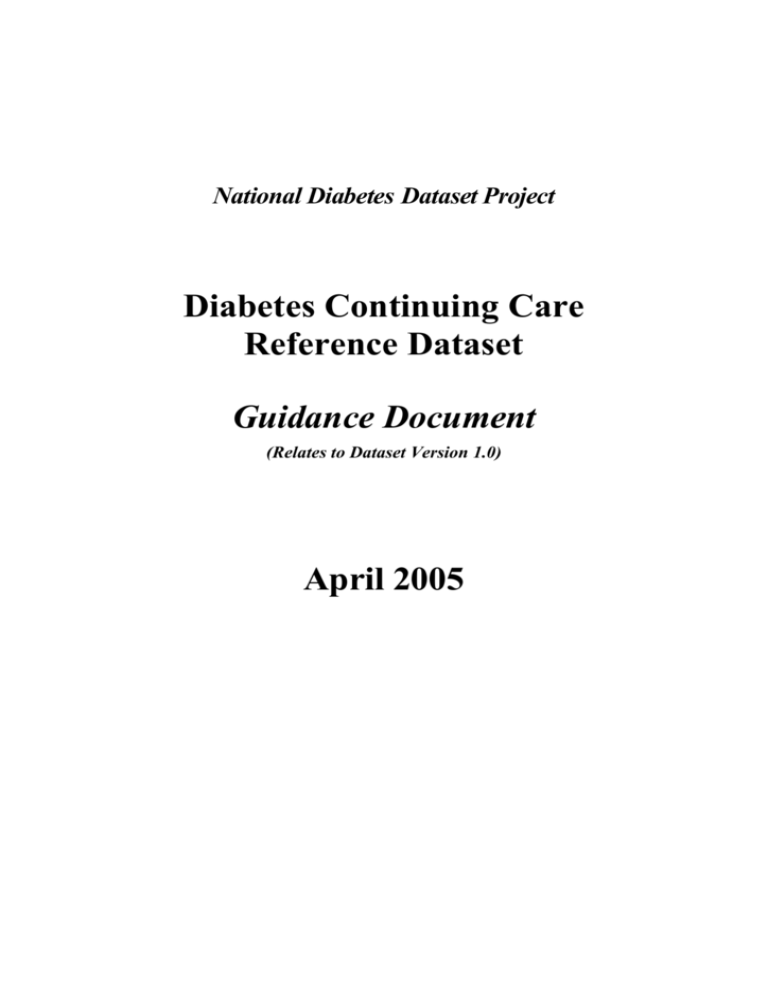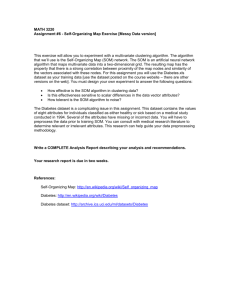National Intervention Classification
advertisement

National Diabetes Dataset Project Diabetes Continuing Care Reference Dataset Guidance Document (Relates to Dataset Version 1.0) April 2005 Purpose of this document This document provides further guidance relating to the Diabetes Continuing Care Reference Dataset. VERSION HISTORY Version Draft V0.1 Date Issued 05/04/05 Owner’s Name Brief Summary of Change Draft V0.1 Maxine Reynolds Distribution On request Author Maxine Reynolds Further copies from Eleanor Bell Health and Social Care Information Centre Kings Court The Broadway Winchester, SO23 9BE : eleanor.bell@ic.nhs.uk E-mail Date of issue April 2005 Guidance Document - Diabetes Continuing Care Reference Dataset CONTENTS 1. NAME OF STANDARD ................................................................................................ 4 2. BACKGROUND INFORMATION .............................................................................. 4 2.1 Relationship to the National Programme for IT .................................................... 4 2.2 Purpose .................................................................................................................. 5 2.4 Where it will be used / Who will use it ................................................................ 6 2.5 Use in routine practice ........................................................................................... 6 3. DETAILS OF THE SPECIFICATION ........................................................................ 7 Version: 0.1 3 Guidance Document - Diabetes Continuing Care Reference Dataset 1. NAME OF STANDARD The standard to which this guidance relates is called the Diabetes Continuing Care Reference Dataset. 2. BACKGROUND INFORMATION 2.1 Relationship to the National Programme for IT The Diabetes Dataset project is a strategic development based on the systems that will incorporate the sharing of information between all health care service providers and patients, across primary secondary and tertiary care. The format specified for each data item is based on the output specifications related to secondary information requirements. Associated with this is an underlying assumption that all data extracted for secondary purposes will be derived from information recorded by the clinician, at the point of care, and will not necessitate double recording. This submission has been developed to support current systems used within the NHS. Prior to the widespread implementation of NPfIT systems, the Diabetes Continuing Care Reference Dataset only incorporates those data items that can be collected using Read Code systems. This will facilitate implementation in the primary care sector at the current point in time. In the short term some associated operational instantiations (in particular NCASP) may extract outcome data from Hospital Episode Statistics (HES). In these cases ICD10 or OPCS4 codes are also provided. In the longer term all secondary information requirements will be extractable from the point of care environment (or the NHS Care Record Service) in a Snomed CT format. As all Read Codes and all ICD10/OPCS4 codes are included within the Snomed CT vocabulary, the transition of this dataset to use in the NPfIT arena should be relatively seamless. A full gap analysis for Snomed CT terms and codes has been requested from the NHS Clinical Terminology Service. Development has also considered alignment with NPfIT for all non clinical data items. As the latter is still a developing area any related data items will not specify detail of format and categories but will refer to the NHS Data Dictionary (NHS DD) and NPfIT (HL7) messaging specifications for further information. This relates in particular to the Demographic Data section. Currently, systems should utilise formats as specified within the NHS DD - however as systems migrate to NPfIT specifications formats will require conformance with the HL7 messaging standards. An example of this is the date format which is currently held within the NHS DD as an e-Gif standard. Version: 0.1 4 Guidance Document - Diabetes Continuing Care Reference Dataset 2.2 Purpose The Diabetes Continuing Care Reference Dataset is a common dataset developed to enable local Diabetes Services, commissioning and planning agencies and national bodies to monitor diabetes continuing care Figure 1: Diagram to summarise the prevention and management of diabetes 1. (The Diabetes Continuing Care Reference Dataset refers to the Continuing Care loop that applies to the whole of the diabetes population). The Diabetes Continuing Care Reference Dataset is a fundamental dataset which will support operational instantiations for specific purposes. Operational instantiations currently include Diabetes National Audit (NCASP), the Diabetes chapter within the new GMS Contract, the DiabetesE performance management tool, and the Diabetes User Dataset (patient information). It should be noted that while the fields of the Diabetes Continuing Care Reference Dataset will normally be recorded within and collected from the diabetes care record, the primary purpose of the dataset is not the direct clinical care of patients. 2.3 Scope The Diabetes Continuing Care Reference Dataset identifies: 1. 2. 3. the standard data elements which satisfy the information requirements to support the monitoring of current national diabetes continuing care guidelines; data standards for the recording of each of these data elements; and the appropriate coding mechanisms. It does not constitute the patient record, nor does it constitute an exhaustive record of the care process. The scope of the dataset has been set to reflect the most recent policy directives in relation to secondary information requirements. At a Diabetes Information Summit 1 http://www.publications.doh.gov.uk/nsf/diabetes/ch2/introduction.htm Version: 0.1 5 Guidance Document - Diabetes Continuing Care Reference Dataset held in June 2004, the following work streams were put forward as the key requirements for the national sharing of diabetes patient care information: 1) The GMS Contract (Diabetes Quality Indicators) 2) National Diabetes Audit (NCASP) 3) Better Metrics, Performance Indicators for Diabetes 4) Diabetes E, Performance Assessment Tool 5) National Screening Committee (NSC), Retinal Screening Programme The Diabetes Continuing Care Reference Dataset will support operational instantiations of the first four work streams specified above. A separate, but aligned, Diabetes Eye Care Dataset has been developed, in conjunction with the National Retinal Screening Programme, and it is the intention to submit this to ISB as an Operational Standard following pilot. In addition there are a very small number of additional data items that have been included in order to provide a balanced view of diabetes continuing care. The scope of this fundamental dataset submission does not include patient confidentiality. However it should be noted that any associated operational instantiations would be required to provide guidance in relation to confidentiality, and the use of patient data for secondary usages. 2.4 Where it will be used / Who will use it The dataset will be used to support quality performance monitoring in all health care settings where diabetes services are delivered. 2.5 Use in routine practice The dataset is a reference dataset which will inform clinical record keeping so that consistent data can be extracted as a byproduct of the patient care record and analysed for secondary uses. Consistency of data will allow information to be made available locally and nationally to clinical governance leads and clinical audit managers for analysis, monitoring and service planning. It is not intended for the whole of the dataset to be collected or extracted at any one time. Although much of the information is often collected at a Diabetes Annual Review, this is not always the case and the dataset will allow healthcare staff to record standardised information at the appropriate stage of the care pathway reached by the patient. Extraction of information for secondary purposes will be undertaken by the various operational instantiations which the dataset has been developed to support. The standard therefore does not include software tools to implement the dataset nor messaging standards for electronic data sharing. Version: 0.1 6 Guidance Document - Diabetes Continuing Care Reference Dataset 3. DETAILS OF THE SPECIFICATION The Diabetes Continuing Care Reference Dataset is presented as a Microsoft Excel document. To facilitate use, columns can be hidden in order to display a preferred view or a print format relevant to a particular user. Within the document different dataset sections are displayed on separate worksheets (e.g. Demographic Data; Diabetes Diagnosis Data; At Risk Data etc.). Each work sheet contains the same headed columns with the exception of the Footnotes section. The following guidance explains the content of each column: Column A: DI No Provides a reference number for the Data Item. Column B: Data Item Name Provides the Data Item name as held in the dataset – using commonly accepted wording. Column C: DD Element name Provides the name of the Data Item* as specified in the NHS DD. These must conform to the Generic Data Model underlying the Data Dictionary. *NB: Within the NHS DD data items are commonly referred to as data elements. Column D: DD Note Provides further information regarding the modelling of the Data Item within the NHS DD. Column E: Description Provides a definitional description of the Data Item. Column F: Requirement Provides the purpose for the Data Item in relation to the business requirement (i.e. the reason why this information may need to be extracted / collected for secondary purposes). Column G: Codes and Classifications Provides the predefined sets of permissible classifications and codes, and the format in which the data should be extracted. Column H: Footnote Provides the number reference for any footnotes associates with the Data Item. The associated text can be found in the Footnotes section included within the Excel document. Columns I-N: Read Coding Provides the associated 4 Byte; 5 Byte and Version 3 terminology codes and terms Version: 0.1 7 Guidance Document - Diabetes Continuing Care Reference Dataset recommended for use at the point of care The Read Code(s) suggested for each data item are those that most accurately reflect the specified definition / description. It should be noted that a wider range of codes may be suggested by GMS and NCASP query sets to allow for more extensive searches. For example codes suggested within the dataset for diagnoses do not include history codes, or tests that confirm a diagnosis. These codes may however be included in query sets to identify diagnostic information that has not historically been recorded using a diagnosis code. Care must also be taken to ensure that any Read Codes used will provide an output in the specified format. This is particularly relevant where a value is required. For example, when recording information following a Blood Pressure reading, any associated Read Codes must provide distinct blood pressure values for Systolic Blood Pressure and Diastolic Blood Pressure. Within the Read Code hierarchy there are codes provided that facilitate the recording of changes in blood pressure reading, however these would not conform to the requirements of the dataset. For some data items a bounded list, or group of Read Codes, has been provided to allow for differing contexts and granularity of information required at the point of care. Where a % sign has been attached to a Read Code this indicates that the code plus all ‘its children’ in the hierarchy are applicable to that data item. If certain codes need to be excluded, then a series of ranges is given. This follows the convention used within Miquest queries. Please note that as at March 2005 not all columns are completed for 4 Byte and Version 3 Read Codes. However a request has been made to the Terminology Service for this work to be completed and the Dataset will be updated as further codes and terms are confirmed. Columns O-P: Snomed Clinical Terms These columns will provide Snomed CT terms and codes. The content of these columns will be dictated by a gap analysis work package which is currently being organised with the Terminology Service. Column Q: ICD10 / OPCS4 Provides ICD10 or OPCS4 codes for those data items that may require extraction using HES data. Column R: Work Streams Provides a reference to each of the work streams associated with the Data Item. Abbreviations used are as follows: GMS: NCASP: PI: DiabetesE: Retinal Screening: The new GMS Contract National Diabetes Audit Better Metrics Performance Indicators for Diabetes Diabetes E, Performance Assessment Tool NSC, Retinal Screening Programme The following work streams/areas have also been referenced where not already reflected in the above: Version: 0.1 8 Guidance Document - Diabetes Continuing Care Reference Dataset NSF: NSFi: NICE: Version: 0.1 National Service Framework for Diabetes A performance indicator project associated with early NSF development National Institute for Clinical Excellence guidelines 9





